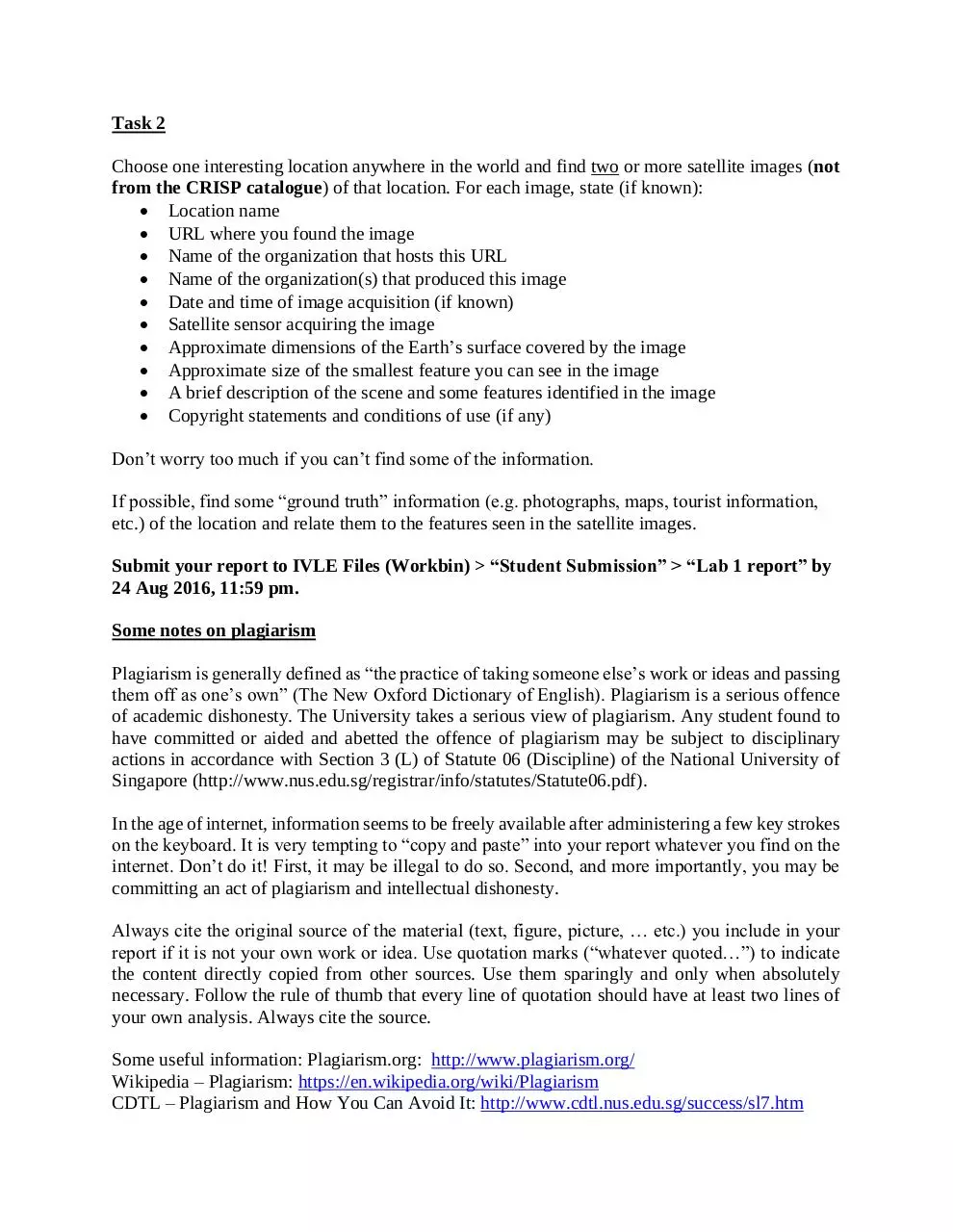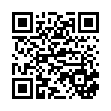GEK2503 Lab1 (PDF)
File information
Author: scliew
This PDF 1.5 document has been generated by Microsoft® Word 2013, and has been sent on pdf-archive.com on 07/10/2016 at 04:43, from IP address 101.127.x.x.
The current document download page has been viewed 990 times.
File size: 162.14 KB (2 pages).
Privacy: public file


File preview
GEK2503: Remote Sensing for Earth Observation
Lab 1: Satellite Remote Sensing Images on the Internet
18 August 2016
Report Submission deadline: 24 August 2015, 11:59 pm.
In this session, we will visit some interesting web sites to look for satellite remote sensing
images. We will also discuss the different types of images that you may encounter. Among the
websites are those maintained by the major space agencies such as NASA, ESA and JAXA,
international ground stations, operational agencies such as NOAA, USGS, and commercial
vendors such as SPOT and DigitalGlobe.
CRISP maintains a web-based catalogue of all images acquired by its ground station.
“Quicklook” images (also known as “browse images”), location maps and metadata (e.g. date
and time of acquisition, imaging modes, geographic coordinates, sun angles, sensor viewing
angles, cloud coverage, etc.) of the archived scenes are available in the catalogue. CRISP started
acquisition of satellite images since September 1995. The web-based catalogue is freely
accessible, but you need to be a registered user before you can access the catalogue.
The quicklook images are reduced resolution images. They enable potential users of the satellite
images choose the scenes that are available, and access their usability before they actually order
the full-resolution images.
Important: Most images you find on the internet are copyrighted material. Before you use
any of these images for whatever purposes, read the copyright statements and conditions of
use.
Task 1
Go to the CRISP catalogue web site and register yourself as a user of the catalogue. Go to
http://www.crisp.nus.edu.sg/ and click on “catalogue” button on the top banner, then follow the
on-screen instructions. It is free! You need to supply your valid email address during the
registration process. It is preferable to use your NUS email. The system will send a password to
you by email almost instantaneously. Logon to the catalogue web site after you have received
your password.
Identify three areas of your interest in Southeast Asia (preferably with different land cover
features). Find a good browse image of each area in CRISP’s archive.
Attach the browse images in your report, and for each image state:
Satellite
Scene ID (the unique ID that identifies each image)
Date and time of acquisition
Location (scene center coordinates, and location name if known)
A brief description of the scene and identify some features observed
Task 2
Choose one interesting location anywhere in the world and find two or more satellite images (not
from the CRISP catalogue) of that location. For each image, state (if known):
Location name
URL where you found the image
Name of the organization that hosts this URL
Name of the organization(s) that produced this image
Date and time of image acquisition (if known)
Satellite sensor acquiring the image
Approximate dimensions of the Earth’s surface covered by the image
Approximate size of the smallest feature you can see in the image
A brief description of the scene and some features identified in the image
Copyright statements and conditions of use (if any)
Don’t worry too much if you can’t find some of the information.
If possible, find some “ground truth” information (e.g. photographs, maps, tourist information,
etc.) of the location and relate them to the features seen in the satellite images.
Submit your report to IVLE Files (Workbin) > “Student Submission” > “Lab 1 report” by
24 Aug 2016, 11:59 pm.
Some notes on plagiarism
Plagiarism is generally defined as “the practice of taking someone else’s work or ideas and passing
them off as one’s own” (The New Oxford Dictionary of English). Plagiarism is a serious offence
of academic dishonesty. The University takes a serious view of plagiarism. Any student found to
have committed or aided and abetted the offence of plagiarism may be subject to disciplinary
actions in accordance with Section 3 (L) of Statute 06 (Discipline) of the National University of
Singapore (http://www.nus.edu.sg/registrar/info/statutes/Statute06.pdf).
In the age of internet, information seems to be freely available after administering a few key strokes
on the keyboard. It is very tempting to “copy and paste” into your report whatever you find on the
internet. Don’t do it! First, it may be illegal to do so. Second, and more importantly, you may be
committing an act of plagiarism and intellectual dishonesty.
Always cite the original source of the material (text, figure, picture, … etc.) you include in your
report if it is not your own work or idea. Use quotation marks (“whatever quoted…”) to indicate
the content directly copied from other sources. Use them sparingly and only when absolutely
necessary. Follow the rule of thumb that every line of quotation should have at least two lines of
your own analysis. Always cite the source.
Some useful information: Plagiarism.org: http://www.plagiarism.org/
Wikipedia – Plagiarism: https://en.wikipedia.org/wiki/Plagiarism
CDTL – Plagiarism and How You Can Avoid It: http://www.cdtl.nus.edu.sg/success/sl7.htm
Download GEK2503-Lab1
GEK2503-Lab1.pdf (PDF, 162.14 KB)
Download PDF
Share this file on social networks
Link to this page
Permanent link
Use the permanent link to the download page to share your document on Facebook, Twitter, LinkedIn, or directly with a contact by e-Mail, Messenger, Whatsapp, Line..
Short link
Use the short link to share your document on Twitter or by text message (SMS)
HTML Code
Copy the following HTML code to share your document on a Website or Blog
QR Code to this page

This file has been shared publicly by a user of PDF Archive.
Document ID: 0000492081.